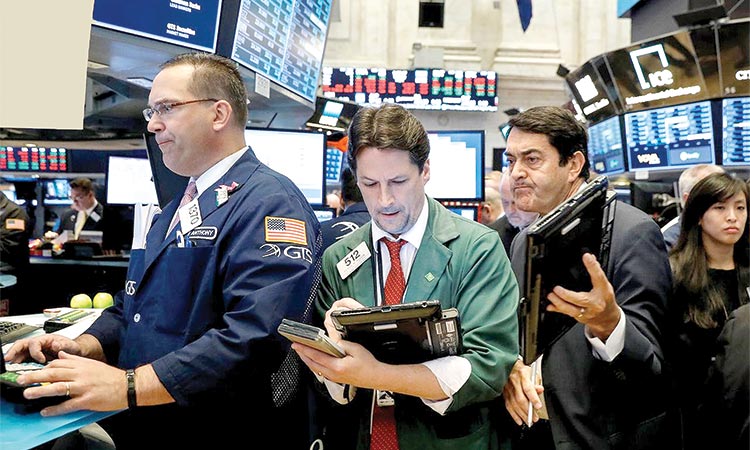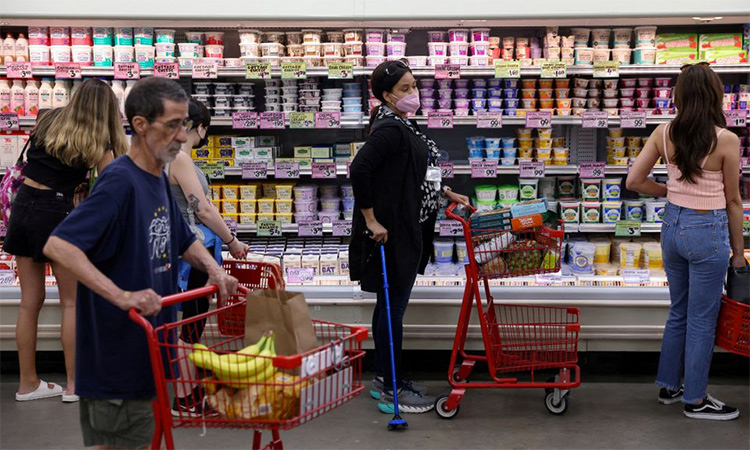US annual inflation slows in June labour costs cool in second quarter

A woman picks up a meat packet at store in Pasadena, California, US. Reuters
The improving inflation environment was underscored by other data on Friday showing labour costs rose at their slowest pace in two years in the second quarter as wage growth cooled.
Receding inflation has raised cautious optimism of a “soft landing” for the economy envisaged by Fed officials rather than the recession that most economists have been predicting.
The US central bank on Wednesday raised its policy rate by 25 basis points to the 5.25 per cent-5.50 per cent range, a level last seen just prior to the 2007 housing market crash and which has not been consistently exceeded for about 22 years.
“The Fed must make more progress, but inflation rates are falling, which at the margin reduces the likelihood of a September rate hike,” said Conrad DeQuadros, senior economic advisor at Brean Capital in New York.
The personal consumption expenditures (PCE) price index increased 0.2 per cent last month after edging up 0.1 per cent in May, the Commerce Department said. Food prices dipped 0.1 per cent while the cost of energy increased 0.6 per cent. In the 12 months through June, the PCE price index advanced 3.0 per cent. That was the smallest annual gain since March 2021 and followed a 3.8 per cent rise in May.
Excluding the volatile food and energy components, the PCE price index gained 0.2 per cent after rising 0.3 per cent in the prior month. That lowered the year-on-year increase in the so-called core PCE price index to 4.1 per cent, the smallest advance since September 2021. The annual core PCE price index climbed 4.6 per cent in May.
Economists polled by Reuters had forecast the core PCE price index would gain 0.2 per cent and rise 4.2 per cent on a year-on-year basis. The Fed tracks the PCE price indexes for its 2 per cent inflation target.
US stocks opened higher. The dollar slipped against a basket of currencies. US Treasury prices rose.
Annual inflation is easing as last year’s surge drops out of the calculations. Food commodity prices are back at levels seen prior to Russia’s invasion of Ukraine in February 2022.
Fed Chair Jerome Powell told reporters on Wednesday that it was “certainly possible that we would raise the (federal) funds rate again at the September meeting if the data warranted.” Powell also added that “it’s possible that we would choose to hold steady at that meeting.”
A separate report from the labour Department on Friday showed the employment cost index, the broadest measure of labour costs, rose 1.0 per cent in the second quarter. That was the smallest increase since the second quarter of 2021 and followed a 1.2% advance in the January-March period. labour costs increased 4.5 per cent on a year-on-year basis after shooting up 4.8 per cent in the first quarter.
The ECI is widely viewed by policymakers and economists as one of the better measures of labour market slack and a predictor of core inflation because it adjusts for composition and job-quality changes.
Wages and salaries rose 1.0 per cent in the second quarter after an increase of 1.2 per cent in the prior three months. They were up 4.6% on a year-on-year basis after advancing 5.0 per cent in the first quarter. Wage growth, however, continues to exceed pre-pandemic rates.
Private-sector wages gained 1.0 per cent after climbing 1.2 per cent in the first quarter. They increased 4.6 per cent on a year-on-year basis.
Inflation-adjusted wages for all workers accelerated 1.7 per cent on a year-on-year basis after being unchanged in the first quarter. The boost to households’ purchasing power is helping to drive consumer spending and keep the economy afloat.
Consumer spending, which accounts for more than two-thirds of US economic activity, increased 0.5 per cent in June after gaining 0.2 per cent in May, the Commerce Department report showed. The data was included in the advance estimate of second-quarter gross domestic product, which was published on Thursday.
Consumer spending increased at a 1.6 per cent annualised rate last quarter, slowing from the 4.2 per cent pace logged in the January-March period. The moderation in spending was partly blamed on difficulties adjusting the data for seasonal fluctuations following the jump in the first quarter. The increase was enough to help boost economic growth to a 2.4 per cent rate last quarter from the 2.0 per cent pace reported in the first three months of the year.
In June, consumer spending was lifted by a surge in motor vehicle purchases as well as financial services and insurance outlays. There also were increases in spending on housing and utilities, recreation services, recreational goods and vehicles as well as furnishings and long-lasting household equipment.







